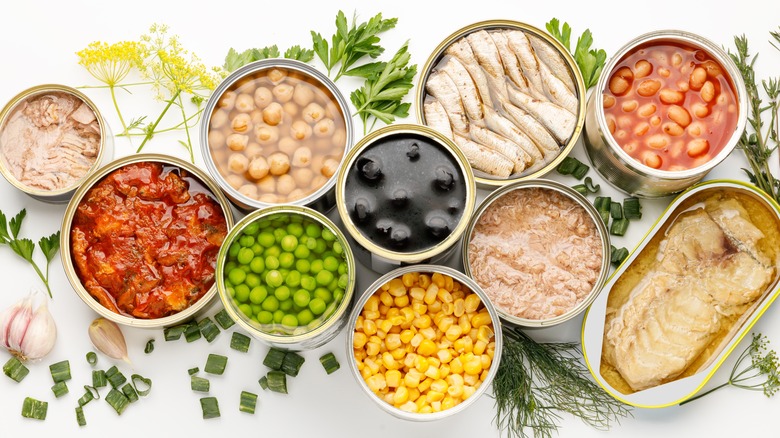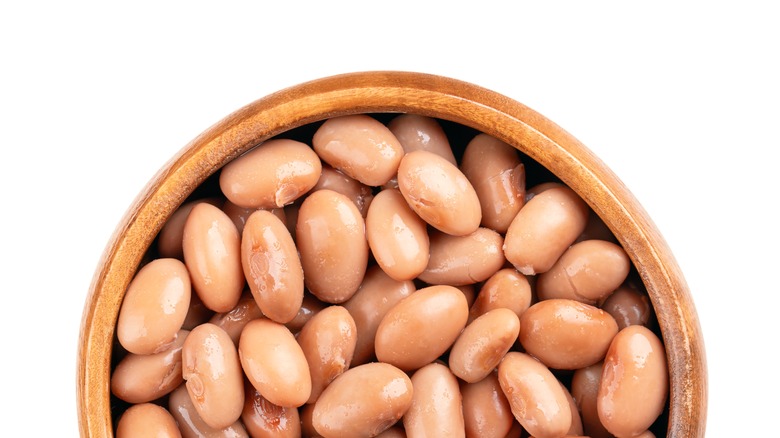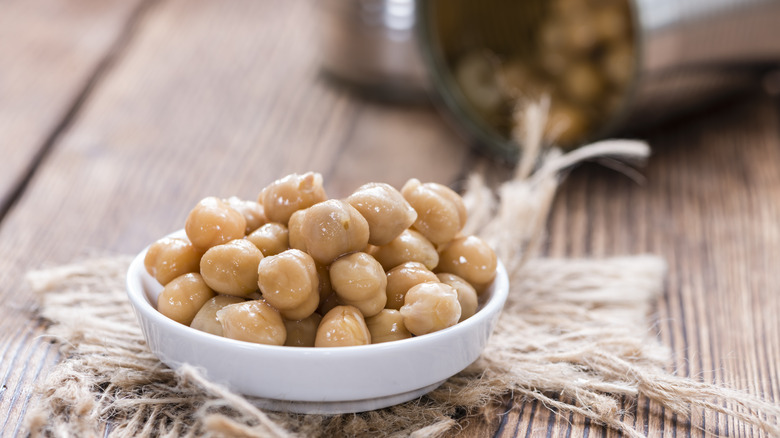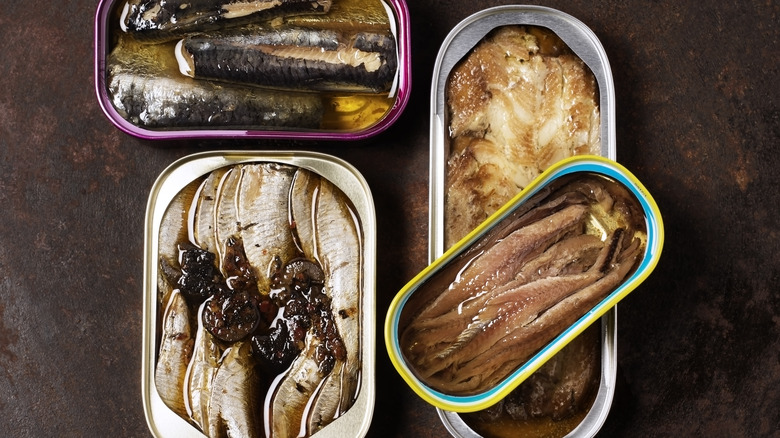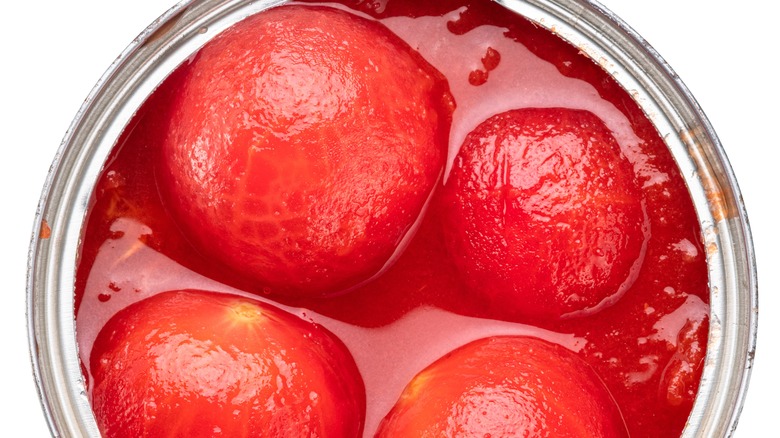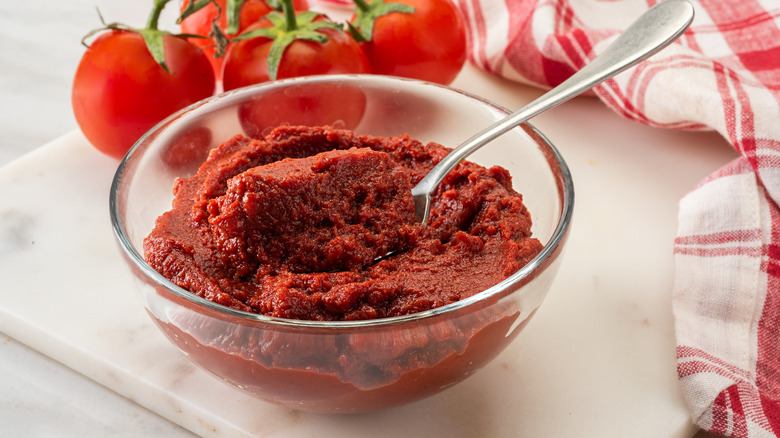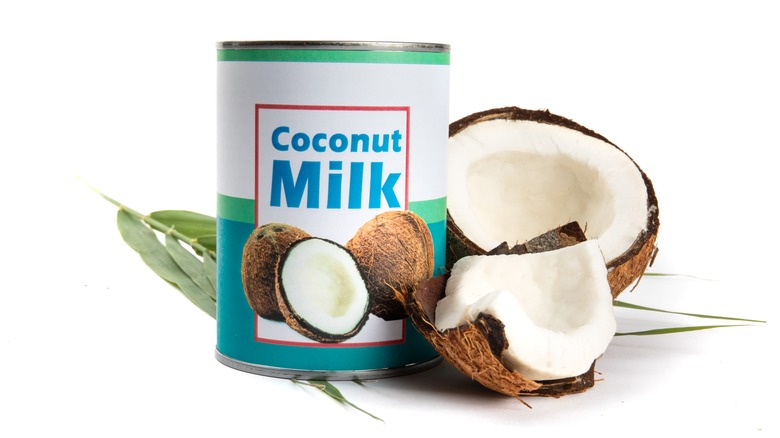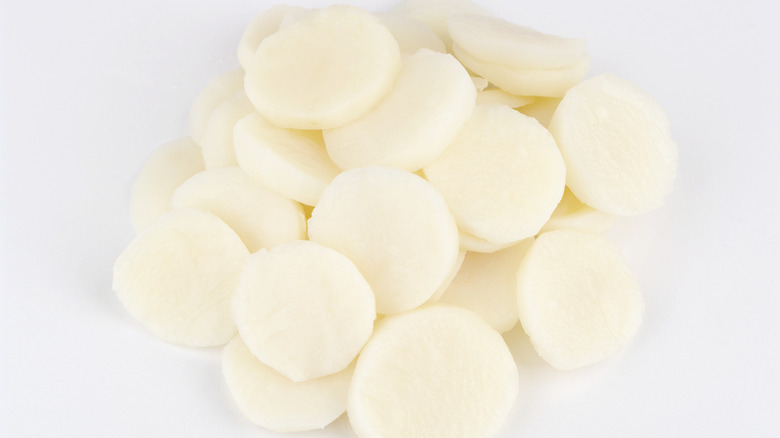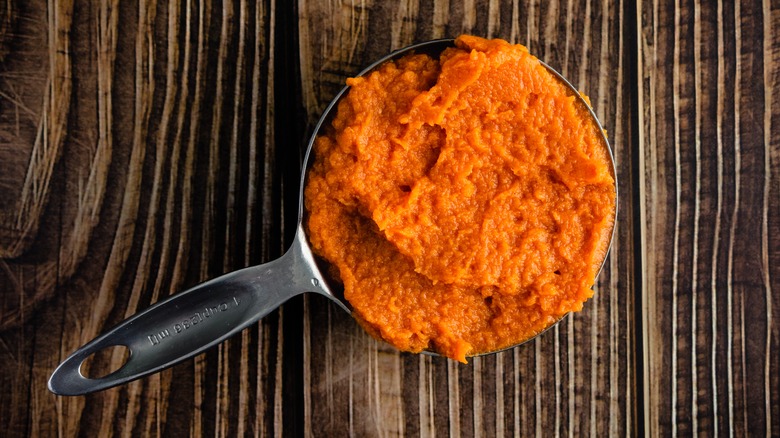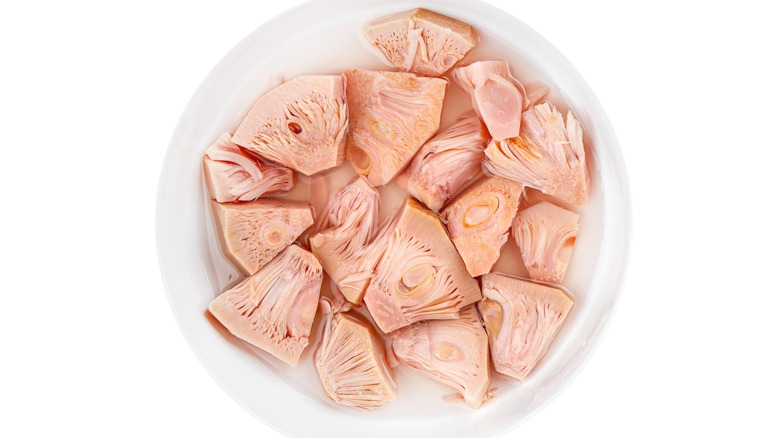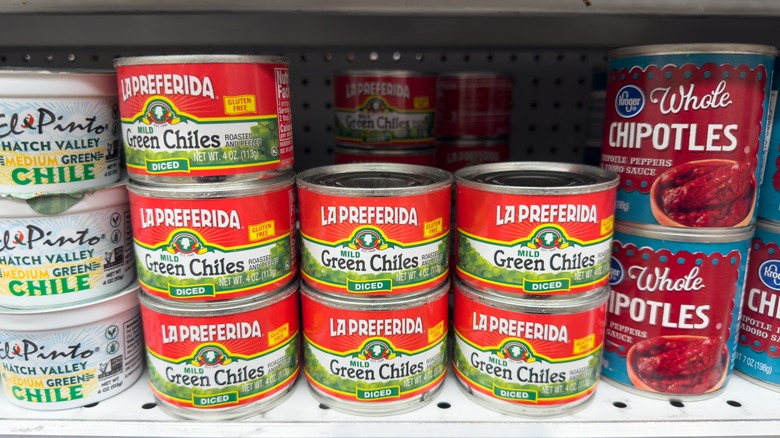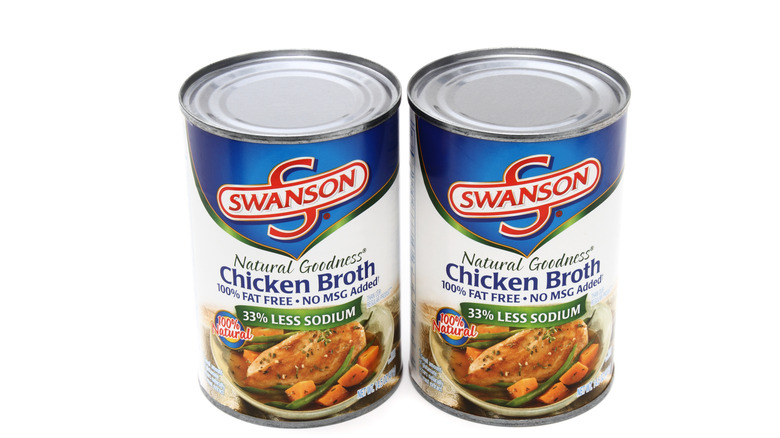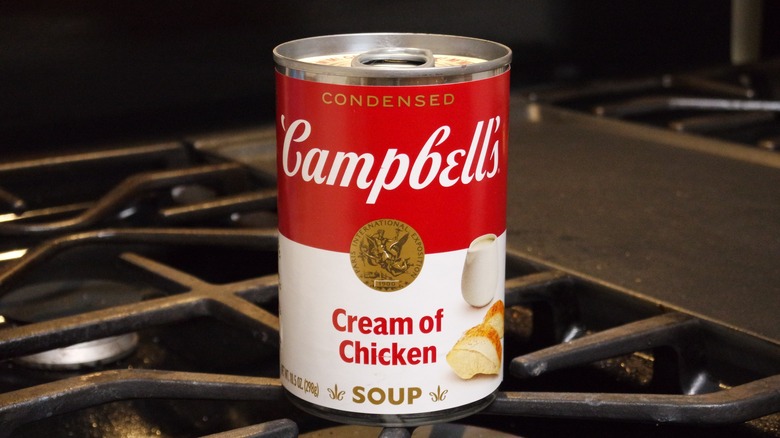Canned Foods You Should Always Keep In Your Pantry
Preserving food is a time-tested tradition, whether that involves pickling, drying, or curing a variety of ingredients. But using pressure-sealed cans to store food is a relatively recent innovation. It's also one that we can attribute, at least in part, to Napoleon. In 1795, the French emperor offered a 12,000-franc prize to anyone who could create a better alternative to the diet of salted meat and hardtack his soldiers had to endure. Some 15 years later, candymaker Nicolas François Appert came up with the basics of canning in 1810. With some more innovation over the centuries, canned goods proliferated and pantries have never quite been the same.
Of course, there's a bit of a dark side. Canned foods have long suffered from a bit of a bad rep, with potential risks that once ranged from botulism via compromised cans to bisphenol A (BPA) leaching into food from can linings. Thankfully, modern advances in food safety and science have largely made these issues a thing of the past. Today, canned foods are above all a useful staple to keep on hand for busy cooks. Canned foods run the gamut from complete meals in a can like canned spaghetti or stew, to staple ingredients that make home cooking a breeze. And while there are loads of choices out there, some are true all-stars. These are the sorts of canned food you should definitely always keep on hand.
Canned beans
Beans are nothing if not a nutritional powerhouse. In general, they represent a great source of plant-based protein and iron, not to mention loads of fiber and other vitamins and minerals. But cooking dried beans can be a long process that usually requires at least enough advance planning for an all-night soak.
Don't have time for all that? Canned beans to the rescue! This cupboard staple isn't just far easier to incorporate into your daily routine than dry beans. In fact, canned beans are pretty much as healthy as dried beans (more so if you opt for low salt or salt-free varieties). Moreover, there's evidence that cooking beans at home may have a bigger carbon footprint than large-scale canning operations, potentially making purchasing canned beans the more environmentally friendly choice (though research there is ongoing).
As for what to do with canned beans, the possibilities are almost endless. Blitz white beans into a tasty, ultra-creamy homemade hummus, or braise those beans until they become ultra creamy and supremely comforting. Canned kidney beans make a delicious addition to a hearty, crunchy salad, and black beans cook up quickly into a slightly spiced Mexican black bean recipe.
Canned chickpeas
Despite the pea part of their name, chickpeas are actually beans. In addition to whatever other beans you've already got in the pantry, you should also be sure to have a tin of chickpeas (also widely known as garbanzo beans) on the shelf. That's because nutrient-dense chickpeas are incredibly versatile and can be easily transformed into a variety of meals, including vegan burger patties, flavorful hummus, and even a plant-based play on tuna salad.
But, in the midst of all that possibility, perhaps our favorite way to enjoy chickpeas is as a protein-rich stand-in for crunchy snacks like chips or pretzels. The simple process of roasting chickpeas with a bit of oil and spice transforms them into a moreish snack that pairs perfectly with a crisp, cold beer (or your other favorite refreshing beverage).
What's more, their richness in fiber and protein ensures that chickpeas will readily fill you up with goodness rather than empty calories, making them a prime choice for health and flavor. Experiment with different spice blends, from powerful curry to herbaceous za'atar to a simple seasoning of salt and pepper to find your favorite play on this snack. Cocktail hour will never be quite the same.
Canned fish
In certain quarters, canned fish has become something of an on-trend staple, taking its turn as the star of seacuterie boards across Instagram and TikTok. Frankly, we're happy to get on board with this health-conscious trend that's as good for our bodies as it is for the planet. Much of the seafood that ends up in tins is of the smaller, more sustainable variety. Little, fat-rich fish like anchovies and sardines are packed with heart-healthy omega-3 fatty acids, too. Canned sardines are delicious enjoyed straight out of the can or served simply on a slice of toast, but why stop there? These are also a wonderful ingredient in a rich sardine pasta recipe. Funky anchovies, meanwhile, are perfectly at home in salad dressings, on sandwiches, or as a staple of Niçoise salad.
These tiny fish do tend to have a more pronounced and sometimes downright pungent flavor. Perhaps this is why so many people choose old reliables like canned tuna and salmon. While these larger, carnivorous fish aren't quite as sustainable as the small fries and may contain more mercury (depending on species and brand), choosing better brands of canned tuna from companies that do their part to fish sustainably is a good choice, too. That's especially so when you consider this food's versatility in dishes like classic tuna salad or pan-fried tuna patties, either of which are a cinch to pull together.
Canned whole peeled tomatoes
We simply refuse to suffer through pale, mealy winter tomatoes, which means that when the abundance of summer's bounty tails off, we rely on canned tomatoes for just about everything from tomato sauce to homemade tomato soup. And while most supermarket aisles have loads of brands and varieties of canned tomatoes from which to choose, from diced to crushed to puréed, it's a no-brainer to stock up on whole, peeled tomatoes in a can.
But why the whole variety? Oftentimes, diced tomatoes are too firm and crushed tomatoes are simply too variable in quality to make for good pantry staples. By contrast, whole peeled tomatoes are less processed than many other types of canned tomato product, making them more versatile. You can easily leave them whole or, with just a bit of extra effort and perhaps a blender, break them up or purée them until smooth. Choose the best canned tomato brand you can find to ensure you're getting top-quality flavor.
Canned tomato paste
In addition to whole, peeled tomatoes, one other canned tomato product that should always have a spot on your pantry shelf is tomato paste. This ultra-concentrated tomato product adds sweet, umami-rich flavor to condiments such as homemade ketchup to tomato sauce, as well as many other dishes. Since a little bit goes a long way, it is often sold in small jars or squeezable tubes that don't take up much precious kitchen real estate.
However, not all tomato pastes are created alike. The best boast a natural sweetness and intense, concentrated flavor, while the worst having an almost metallic taste that could throw a whole meal off. It might not have the starring role in most recipes, but choosing the right tomato paste brand can make all the difference. As an added bonus, you can freeze leftover tomato paste in ice cube trays. Stored correctly and used in time, this method can prevent it from going off and ensure you've always got a bit of tomato paste on hand to add depth to your favorite recipes.
Canned coconut milk
If you want to add a creamy, rich flavor and smooth texture to your homemade curries and dals, then be sure you've always got a can or two of coconut milk standing by in the cupboard. This ingredient is typically rich in medium-chain triglycerides, a type of fat that a 2018 study published in PLoS One showed may promote increased metabolism and enhance exercise endurance. Coconut milk is also rich in essential minerals like manganese and copper, making it a bona fide superfood that's more than worthy of the name. It's just as welcome in savory dishes as in sweets, too. For instance, coconut milk, sticky rice, and mango are a classic Thai combination that many agree is simply perfect for dessert.
Be sure to seek out full-fat coconut milk to get the best bang for your buck. So-called light coconut milk is merely a watered-down iteration of the real thing, meaning you're essentially paying more for something you could get for free if you simply walk over to the tap in your own kitchen. While you're considering the can label, be mindful of any emulsifiers or stabilizers that could make this particular canned food a no-go for some.
Canned water chestnuts
Water chestnuts are a bit of an outlier on this list, as many shoppers may perhaps consider then to be more retro in appeal. But if you're feeling a little skeptical, stay with us. We think they're well worth having in the pantry. First of all, despite the name, water chestnuts aren't actually nuts. They're actually a low-calorie aquatic tuber that is rich in fiber and antioxidants, as well as texture, making it a healthy staple that's ready for its curtain call. Available canned both whole and sliced, water chestnuts are a versatile ingredient that lend themselves well to all manner of recipes.
Water chestnuts have a crunchy texture and refreshing, mild flavor that make them a welcome addition to Asian-inspired stir fries and slaws. Lean into their '60s appeal in transforming them into bacon-wrapped rumaki or stir-fry them with veggies in a flavorful sauce that they're sure to soak up. In addition to using them in a host of recipes, we quite like enjoying water chestnuts as a healthy snack that we dip in a bit of soy sauce for added flavor.
Canned pumpkin
Fans of pumpkin pie surely already have a can of Libby's waiting for them in the cupboard, but did you know that what may beAmerica's most famous canned pumpkin isn't actually pumpkin at all? That's because most canned pumpkin is actually a variety of winter squash known as Dickinson, which is not dissimilar in flavor and texture to butternut squash. However, we can at least report that the reasons for this frequent mislabeling are far from nefarious. True pumpkins tend to be a bit stringier than other varieties of winter squash, which cook down into the creamy, flavorful purée you're used to — and which play much better in a wider variety of recipes. Plus, we think that Dickinson Spice Latte just doesn't have quite the same ring to it.
Either way, canned pumpkin (er, winter squash) is good to have on hand for more than just pie. From sweet bakes like copycat Starbucks pumpkin bread to savory dishes such as pumpkin curry sauce, there are loads of creative ways to take advantage of a can of pumpkin in your cupboard.
Canned jackfruit
Jackfruit has recently become a bit of a darling among plant-based diners, who take advantage of the tropical fruit's mild, subtle flavor and shreddable texture to transform it into a vegan alternative to pulled pork or chicken. And canned green jackfruit (avoid the sweeter mature variety) has an added bonus over fresh, in that it's ready to use straight out of the can.
Jackfruit makes for a great vegan taco filling or nacho topping, especially when seasoned with smoky chipotle chiles. And when it comes to vegan pulled pork sandwiches, there's no better star than the humble jackfruit. But jackfruit is so much more than a meat replacement. In traditional Punjabi cuisine, jackfruit can be transformed into anything from a savory curry to a bright, spicy pickle. And around Goa, India, it can be used to make a tasty coconut cake that's traditionally cooked over hot coals and sweetened with jaggery, an unrefined sugar with a richer flavor than the far more refined white sugar variety.
Canned chiles
If you're looking to add som eeasy pizzazz to a dip, salad, or taco filling, then all you really need to do is to reach for a can of chiles. Canned chiles are an easy-to-use staple, and with so many different types waiting for you on the grocery store shelf, they're sure to add quite a lot of variety to your meals as well.
Canned green chiles are a supermarket staple and readily become the star of dishes like enchiladas or green chile mac and cheese. These chiles tend to be milder in flavor, adding a lovely vegetal quality and a subtle heat to these recipes. Jalapeños tend to be canned in brine, adding a lovely acidic brightness when they're used as a topping for tacos or nachos. For many spice-loving folks, canned jalapeños also bring some welcome heat when they're used in place of classic dill pickles in potato salad.
But if we were going to pick just one canned chile to have ready to go at all times, it would undoubtedly be the canned chipotle. These smoked, dried jalapeños are subtly spicy and richly flavorful and the adobo sauce in which they're typically canned offers its own aromatic richness. That little can represents the perfect way to add smoky flavor and heat to seemingly anything from mashed potatoes to pasta to mayonnaise. Try it for yourself, and it will be no surprise to hear that celebrity chef Bobby Flay swears by them.
Canned broth and stock
Making broth and stock from scratch is a labor of love, and while we will admit that there's nothing quite like the homemade stuff, we're also often working with limited time and energy. Keeping a can or two of the ready-made variety in the pantry is an easy way to ensure dishes, such as a hearty, satisfying, and quick chicken noodle soup, are always just within your reach.
While you're at the store, be sure to choose low-sodium broth. This isn't just for your health, but also for flavor. Working with low-sodium ingredients will give you better control over how salty the finished dish will be.
Canned and boxed stocks can unfortunately be thinner than homemade. That's due to a lack of gelatin, which is naturally extracted from bones when you simmer them slowly at home. That said, this state of affairs is changing with the increased prevalence of store-bought bone broth, which tends to be thicker and richer in collagen than run-of-the-mill broth. As a nutrient powerhouse, store-bought bone broth isn't just an ingredient in other dishes. It can also be simply heated and sipped as a satiating warm beverage.
Canned soup
There's something so nostalgic about a can of soup. However, the unfortunate reality is that it's not always the best choice when it comes to your health. Many canned soup brands are packed full of preservatives and sodium, transforming what may first seem like a healthy choice into nothing less than a processed disaster. But some canned soup brands are head and shoulders above the rest. These rely on top-quality ingredients and minimal processing to deliver a quick and easy meal option that's filled with nutrients.
A can of soup can be easily enjoyed on its own or paired with a slice of crusty bread to make a filling and savory meal, but there's no reason to stop there. You can also doctor canned soup to make it taste even better. Add a serving of extra vegetables or some leftover rice to a can of soup for even more texture and flavor. Or, you could go classic rainy day and pair canned soup with a homemade toastie or grilled cheese to make it that much more satisfying. And don't forget that canned soup has long been used as the backbone for all-American casseroles that are hearty, delicious, and thoroughly crowd-pleasing.
